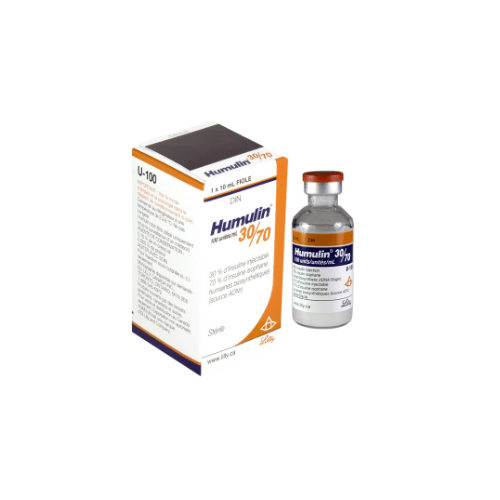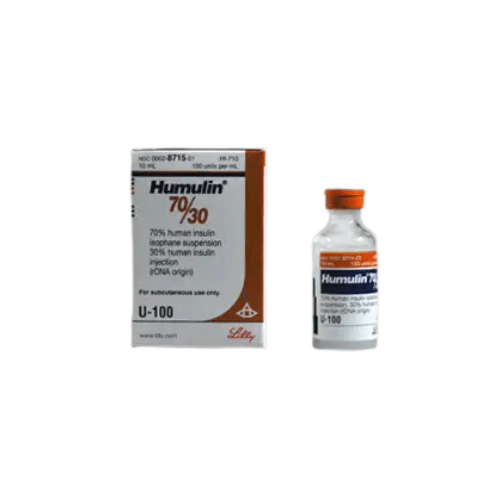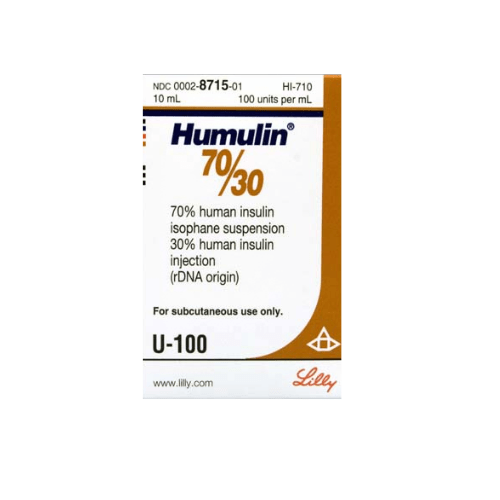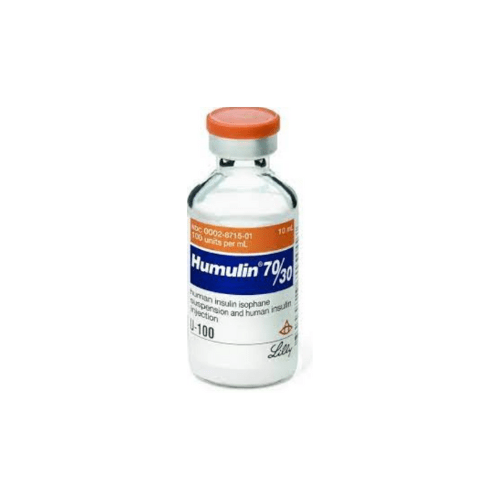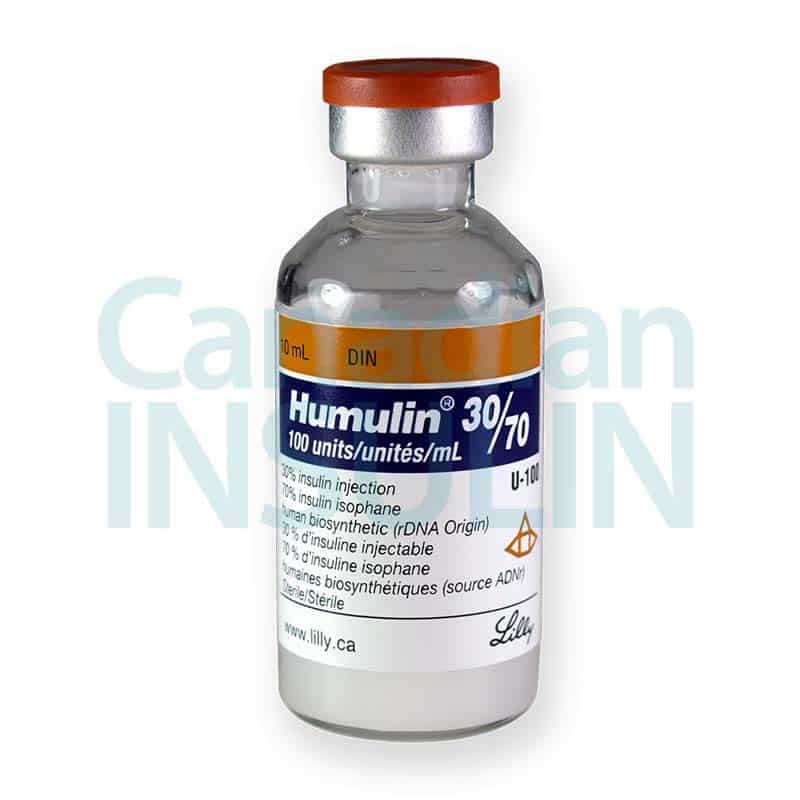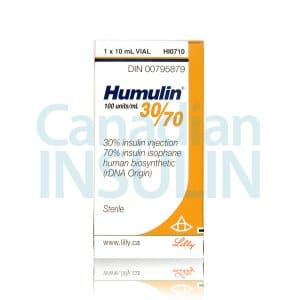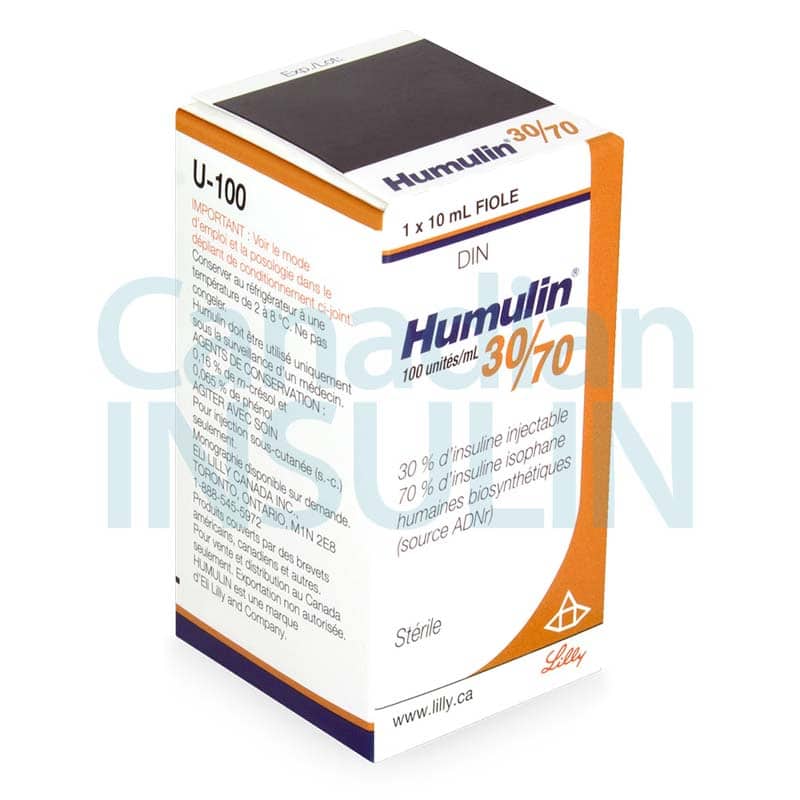Please note: a valid prescription is required for all prescription medication.
Humulin 30/70 Vial is a premixed human insulin used to control blood sugar in diabetes. This page explains how it works and how to use it safely, with clear steps and comparisons you can act on with US delivery from Canada. Many people also research Humulin 30/70 vial without insurance to understand access and out-of-pocket costs.
What Humulin Is and How It Works
Humulin® 30/70 combines 70 percent NPH (intermediate-acting) insulin with 30 percent regular (short-acting) insulin. The short-acting part starts to cover meals, while the intermediate part provides background control between doses. This premix may reduce the need to measure and mix separate insulins. For a deeper overview of premixed insulin types and timing, see our Premixed Insulin Guide, or browse similar options in Premixed Insulin.
CanadianInsulin.com is a prescription referral platform. We verify prescriptions with your prescriber when required, and licensed Canadian pharmacies dispense your order.
This medicine works by replacing or supplementing your body’s insulin to move glucose from the blood into cells. Typical onset reflects its components: meal coverage begins soon after dosing, while basal coverage follows later. Do not use this insulin in an insulin pump, and do not inject into a vein or muscle.
Some patients may know this premix by regional naming; for example, Huminsulin 30/70 vial appears in certain markets with comparable composition. Always follow your prescriber’s product-specific instructions.
Who It’s For
This treatment is indicated to improve glycemic control in adults and children with diabetes mellitus. It can be used in Type 2 Diabetes when insulin is needed, and in type 1 diabetes as part of a comprehensive plan.
People considering Humulin 70/30 vial should not use it during episodes of hypoglycemia or if they have had hypersensitivity to any ingredient. It is not for diabetic ketoacidosis; rapid-acting insulin with intravenous fluids and electrolytes is standard care in that setting. Discuss pregnancy, breastfeeding, and any comorbidities before starting.
Dosage and Usage
Dosing is individualized. Your clinician will set a schedule based on glucose patterns, meals, and activity. This medicine is given by subcutaneous injection, typically within 30 minutes before a meal. Rotate injection sites within the same region to reduce lipodystrophy.
Use the vial with insulin syringes that match U-100 insulin. Roll the vial gently between your palms until the suspension looks uniformly cloudy. Do not shake vigorously. Inspect for clumps or particles; do not use if you see frosting, sediment, or clear fluid. The Humulin 30/70 insulin vial should never be mixed with other insulins in the same syringe. Do not share needles or syringes.
Never adjust your dose without medical guidance. If you or your clinician need a refresher on typical frameworks, our Insulin Dosage Chart explains common approaches and terminology.
Strengths and Forms
This premixed insulin is supplied in multiple presentations; availability can vary.
- Humulin 70/30 10 mL vial for use with U-100 insulin syringes
- U-100 concentration (100 units/mL) suspension
- Some markets offer cartridges for compatible pens; check local availability
If you use cartridges, you may also review our compatible Penfill Cartridges to understand device-based options.
Missed Dose and Timing
If you miss a scheduled dose, check your blood glucose, consider when you last ate, and contact your care team for advice. Do not double up the next dose. Avoid dosing too close together, which can increase hypoglycemia risk. Keep fast-acting carbohydrates available in case of low blood sugar symptoms.
If you are unsure about the timing around meals, ask your clinician to clarify the premeal interval and how to adjust for delayed or skipped meals.
Storage and Travel Basics
Unopened vials should be refrigerated as directed in the official labeling. Do not freeze, and keep away from direct heat and light. Once in use, a vial may be kept at room temperature for the labeled in-use period; discard on the date your pharmacist or clinician advises. Keep out of reach of children.
When traveling, carry insulin in your hand luggage with a copy of your prescription. Use an insulated case with cold packs if needed, but prevent direct contact with ice or gel packs. Do not use insulin that has been frozen or shows clumping or discoloration. Keep supplies together, including syringes, alcohol swabs, and a sharps container or approved alternative for safe disposal.
Check airline and security rules before flying, and bring documentation for diabetes supplies. If crossing time zones, discuss dose timing with your care team ahead of the trip.
Benefits
This premix can simplify a twice-daily plan by combining mealtime and background insulin into one suspension. It may reduce the number of vials and steps compared with separate NPH and regular injections. Many people find predictable routines easier with a fixed ratio.
- Simplified regimen: one premix covers meals and basal needs
- Consistent components: fixed 70/30 ratio in every dose
- Flexible sites: abdomen, thigh, buttock, or upper arm
- Action profile: early mealtime effect with intermediate coverage
Side Effects and Safety
Common effects include mild injection site reactions, itching, flushing, or edema. Weight gain can occur with improved glycemic control. Hypoglycemia is the most frequent adverse effect and can present with sweating, tremor, hunger, headache, or confusion.
- Low blood sugar: shakiness, dizziness, confusion
- Injection site issues: redness, swelling, or itching
- Allergic reactions: rash or hives
- Fluid retention: ankle swelling
Serious or rare risks include severe hypoglycemia, hypokalemia, and generalized hypersensitivity. Thiazolidinediones taken with insulin may cause or worsen heart failure; monitor for shortness of breath or rapid weight gain. Carry a source of fast sugar and consider glucagon training for close contacts.
Drug Interactions and Cautions
Glucose-lowering agents such as sulfonylureas, GLP-1 receptor agonists, SGLT2 inhibitors, and pramlintide may increase hypoglycemia risk when used with insulin. Beta blockers can mask adrenergic symptoms of low blood sugar. Alcohol may unpredictably affect glucose control. Corticosteroids, certain diuretics, and sympathomimetics can raise glucose and may require closer monitoring.
Do not share needles or vials. Monitor more often during illness, changes in activity, or medication adjustments. Wear medical identification indicating you use insulin.
What to Expect Over Time
After dosing, you can expect early mealtime coverage from the regular insulin component and longer background coverage from the NPH component. Individual response varies with dose, meal timing, and injection site. Steady routines, consistent meals, and regular glucose checks can help your care team adjust the plan as needed.
Track readings and any symptoms in a log. Bring records to appointments so your clinician can review patterns and adjust safely.
Compare With Alternatives
Other premixed human insulins offer a similar fixed ratio. If you prefer the same 70/30 balance from a different brand, consider Novolin ge 30 70. For a mix that uses rapid-acting analog plus protamine for background, some patients use Humalog Mix KwikPens. Discuss differences in timing, device preference, and dosing flexibility with your clinician.
Pricing and Access
Canadian pricing often differs from local retail figures. We provide transparent product pages so you can compare options and plan refills with US shipping from Canada. If you are researching huminsulin 30 70 vial price, review our product details and talk with your prescriber about prescription quantities that fit your budget and care plan.
Checkout is secure with encrypted payment processing. If you are looking for current offers, visit our Promotions page for any available savings information.
Availability and Substitutions
Supply can vary by pharmacy and season. If your item is temporarily unavailable, your prescriber may recommend a therapeutically appropriate alternative in the same class or a different insulin schedule. Do not switch products without professional guidance, as timing and dose adjustments can differ.
Patient Suitability and Cost-Saving Tips
This treatment may suit people who benefit from a consistent meal schedule and a combined basal–bolus approach in one suspension. It may not suit those needing fine-tuned prandial flexibility or pump therapy.
- Multi-month fills: align prescription quantities with follow-up timelines
- Refill reminders: set calendar alerts to prevent gaps
- Travel planning: carry extra syringes and a backup vial
- Supplies check: keep test strips, lancets, and glucose tabs on hand
- Pattern review: share logs for safer dose adjustments
Questions to Ask Your Clinician
- Ideal premeal timing for my routine
- Target glucose ranges and testing frequency
- Signs of low or high blood sugar to watch
- How illness or exercise changes dosing plans
- Whether another premix or basal–bolus plan fits better
Authoritative Sources
For detailed composition, administration, and safety, consult the FDA label on DailyMed.
For manufacturer product information, review the latest prescribing data from Eli Lilly’s official resources available on their product information site.
For Canadian market details and listings, see Health Canada’s Drug Product Database and search the product name on the DPD portal.
For browsing related treatments, explore our broader Insulin Category for vial and pen options that match your care plan.
Ready to proceed? You can place your order with prompt, express, cold-chain shipping. Medical disclaimer: This content is for informational purposes only and is not a substitute for professional medical advice.
Express Shipping - from $25.00
Shipping with this method takes 3-5 days
Prices:
- Dry-Packed Products $25.00
- Cold-Packed Products $35.00
Standard Shipping - $15.00
Shipping with this method takes 5-10 days
Prices:
- Dry-Packed Products $15.00
- Not available for Cold-Packed products
Is Humulin 30/70 the same as 70/30 insulin?
Yes. Humulin 30/70 and Humulin 70/30 refer to the same fixed-ratio premix of 70% NPH and 30% regular human insulin. Naming varies by region or manufacturer labeling.
When should I inject Humulin 30/70 relative to meals?
Labeling generally advises injecting within 30 minutes before a meal because the regular insulin component begins acting shortly after dosing. Your clinician sets the exact timing for you.
Can I use Humulin 30/70 in an insulin pump?
No. This premixed insulin is not approved for use in insulin pumps. It is for subcutaneous injection with syringes. Do not give intravenously or intramuscularly.
How long does a vial last after first use?
Follow the in-use period in the official label and your pharmacist’s guidance. Many vials are discarded after a set number of days at room temperature. Do not use past the labeled period.
What should I do if my blood sugar goes low?
Treat hypoglycemia promptly per your care plan, often with fast-acting carbs like glucose tablets or juice. Recheck glucose and contact your clinician if symptoms persist or are severe.
Can I mix this insulin with other insulins in the same syringe?
No. Premixed 70/30 insulin should not be mixed with other insulins in a syringe. Doing so can change action profiles and increase risk of hypo- or hyperglycemia.
How is this different from using separate NPH and regular insulin?
The premix combines fixed amounts of NPH and regular insulin, simplifying dosing. Separate NPH and regular allow more flexible adjustments but require more steps and calculations.
Rewards Program
Earn points on birthdays, product orders, reviews, friend referrals, and more! Enjoy your medication at unparalleled discounts while reaping rewards for every step you take with us.
You can read more about rewards here.
POINT VALUE
How to earn points
- 1Create an account and start earning.
- 2Earn points every time you shop or perform certain actions.
- 3Redeem points for exclusive discounts.
You Might Also Like
Related Articles
Zepbound storage: Keep It Safe With Clear Temperature Rules
This guide explains Zepbound storage so your medication stays effective. You will learn temperature limits, how long doses can stay unrefrigerated, travel practices, and what to do if a pen…
Zepbound and Fatigue: Practical Tips to Ease Tiredness Safely
Feeling drained after starting tirzepatide can be unsettling. Many users describe a mix of low energy, mild aches, and disrupted sleep early on. If you are navigating Zepbound and fatigue,…
Mounjaro Heart Benefits Beyond Weight Loss: What Matters
Key Takeaways Beyond weight: Heart-related effects may involve blood sugar, blood pressure, and inflammation. Evidence is evolving: Large outcome trials help clarify real-world heart risk. Heart rate can rise: Small…
Ozempic Rebound: A Practical Guide to Prevent Weight Regain
Many people stop GLP-1 therapy and wonder what comes next. Appetite changes, routine shifts, and metabolism can collide. A clear plan helps you keep progress steady and predictable, not reactive.…

